Civic
Type R
 Undoubtedly,
the second generation Civic Type R intends to beat the opposition to
become
the world's best hot hatch, a thing the first generation not quite
achieved.
In fact, the domestic bounded first generation was even unheard to many
foreigners - car journalists included. Autocar, Car, Top Gear, Auto
Express
.... none of them mentioned the old car in their reviews of the new
Type
R. So let me start from the old car first. Undoubtedly,
the second generation Civic Type R intends to beat the opposition to
become
the world's best hot hatch, a thing the first generation not quite
achieved.
In fact, the domestic bounded first generation was even unheard to many
foreigners - car journalists included. Autocar, Car, Top Gear, Auto
Express
.... none of them mentioned the old car in their reviews of the new
Type
R. So let me start from the old car first.
Technical view
The old car was a
racy conversion
from the Civic 3-door, powered by a small-but-high-revving 1.6-litre
VTEC
delivering 185ps. That was achieved by thorough tuning such as human
forged
and polished pistons and lightweight components. The chassis was beefed
up by suspension tower struts front and rear, providing the rigidity
that
the stiffened suspensions needed. At 1080kg, it was very light by any
standard,
thanks to the absence of most equipment and the use of Recaro racing
buckets.
 Now
comes the new Civic Type R. Like the new Civic 3-door, you can find a
label
"Made in Great Britain" as it is produced exclusively in Honda's
Swindon
plant rather than in Japan. This implies 3 things - firstly, sales of
Honda
Europe dropped sharply in recent years so that the Swindon plant has so
much excess capacity to take on any projects; secondly, the new Type R
will be produced in more standardized way rather than human-intensive
method.
Otherwise its production will be left in Japan; lastly, the chassis and
suspensions were thoroughly tested and tuned in Europe, guaranteeing a
world-class handling and ride. Now
comes the new Civic Type R. Like the new Civic 3-door, you can find a
label
"Made in Great Britain" as it is produced exclusively in Honda's
Swindon
plant rather than in Japan. This implies 3 things - firstly, sales of
Honda
Europe dropped sharply in recent years so that the Swindon plant has so
much excess capacity to take on any projects; secondly, the new Type R
will be produced in more standardized way rather than human-intensive
method.
Otherwise its production will be left in Japan; lastly, the chassis and
suspensions were thoroughly tested and tuned in Europe, guaranteeing a
world-class handling and ride.
The regular Civic
3-door
is already 50mm shorter and 60mm lower than the jumbo 5-door version,
and
has a wheelbase a massive 110 mm shorter. The Type R shares the same
bodyshell
but with the suspension dropping 15mm to lower center of gravity. Of
course,
the monocoque is also strengthened - including tower struts - to keep
suspension
geometry unchanged on twisty roads. Still, you can feel the car much
bigger
than the first generation Civic Type R, mostly because of its excessive
height which has grown 60mm to accommodate the high-floor design. What
you might not notice is that it is shorter in overall length as well as
wheelbase than its predecessor. But that means little to the scale, as
it weighs 1200kg, that's 120kg heavier than the old car. Even with the
additional equipment taken into account, the new Type R still feels not
very R (which originally stands for Racing).
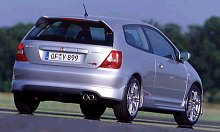 I
did not expect the fat, monospace profile looks good in Type R spec.,
but
this time Honda make it just right. Big air dam, side skirts, rear
spoiler
and 17-inch wheels succeed to change how we feel - instead of plain and
bulky, now the car is subtle. Oh yes, the red R logo at the grille also
plays an important role. It reminds me this is not just a GTI, but a
Type
R ! I
did not expect the fat, monospace profile looks good in Type R spec.,
but
this time Honda make it just right. Big air dam, side skirts, rear
spoiler
and 17-inch wheels succeed to change how we feel - instead of plain and
bulky, now the car is subtle. Oh yes, the red R logo at the grille also
plays an important role. It reminds me this is not just a GTI, but a
Type
R !
The previous
1.6-litre VTEC
was highlight of the car but also the biggest weakness, blame to its
peaky
manner and lack of real torque. New Type R shares engine and gearbox
with
sister car Integra Type R, gaining 400 c.c. and new i-VTEC valve
mechanism.
The i-VTEC still incorporates cam-changing VTEC, which switch to
high-lift,
fast-timing lobes once the engine rev pass 6,000rpm, now it also gets a
cam-phasing variable valve-timing adjusted continuously across the
whole
rev band. As a result, low to mid-range torque, hence tractability, is
greatly improved. The torque curve now peaks at 6,500rpm, with a
useful,
if not 2-litre-class-leading, 144lbft available. This is far stronger
than
the old 1.6's 118lbft at 7,300rpm.
Rev to 7,400 rpm,
the 2-litre
four squeezes out its maximum 200 horsepower, that's European DIN
horsepower.
While it may not match Integra Type R's 220hp (JIS), its lower, 11.0:1
compression allows the engine to drink regular RON95 fuel instead of
98.
In other words, that's the same engine as Acura RSX Type S.
On the road
A hot hatch
having 200 horsepower
is no longer a dream now. Yes, I know Volkswagen group has at least 3
hatches
boosting more power (yet even more torque) and 4-wheel drive, but they
are so heavy and pricey that should be classified as sports sedans
rather
than hot hatches. A hot hatch should be reasonably priced and fairly
lightweight
to have fun on twisty roads. The Type R Civic is undoubtedly a hot
hatch,
just hotter than any other hatches we have ever seen.
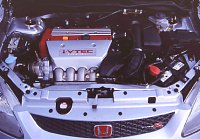 There
is no question about its claimed 0-60 time of 6.8 seconds and a top
speed
of 146mph. The only hot hatch that could rival and possibly beat the
Type
R is Renault Sport's Clio RS (172), which does 0-60 in 6.6 seconds but
it is no where near the Type R at high speed, blame to inferior
aerodynamics
and less top end grunt due to the lack of VTEC (the Clio has VVT only
but
not variable lift). Once the needle pass 6,000rpm, the Honda engine
goes
mad and it really enters a league of its own - no matter aurally or
objectively.
No other 4-cylinder engines could be so thrilling. However, what makes
the i-VTEC a double-edge sword is that it pulls cleanly right from
1,500rpm
and goes really strong from 3,000rpm where 90% torque is available. The
continuous VVT also smoothens power delivery thus it is refined to use
in daily basis, a thing the old VTEC can hardly claim. There
is no question about its claimed 0-60 time of 6.8 seconds and a top
speed
of 146mph. The only hot hatch that could rival and possibly beat the
Type
R is Renault Sport's Clio RS (172), which does 0-60 in 6.6 seconds but
it is no where near the Type R at high speed, blame to inferior
aerodynamics
and less top end grunt due to the lack of VTEC (the Clio has VVT only
but
not variable lift). Once the needle pass 6,000rpm, the Honda engine
goes
mad and it really enters a league of its own - no matter aurally or
objectively.
No other 4-cylinder engines could be so thrilling. However, what makes
the i-VTEC a double-edge sword is that it pulls cleanly right from
1,500rpm
and goes really strong from 3,000rpm where 90% torque is available. The
continuous VVT also smoothens power delivery thus it is refined to use
in daily basis, a thing the old VTEC can hardly claim.
 Integra's
6-speed manual is another joy. Although the shifter is mounted on
center
console like many MPVs, it actually shortens the distance travelling
from
steering wheel to shifter. Moreover, shift quality remains unchanged at
the best tradition of Honda - slick, precise and short-throw. 6 close
ratios
keep the engine boiling at VTEC zone. Integra's
6-speed manual is another joy. Although the shifter is mounted on
center
console like many MPVs, it actually shortens the distance travelling
from
steering wheel to shifter. Moreover, shift quality remains unchanged at
the best tradition of Honda - slick, precise and short-throw. 6 close
ratios
keep the engine boiling at VTEC zone.
Now enter twisty
roads to
test its handling. Also enter the scene is the mighty Peugeot 306
GTi-6,
our long-time beloved, and the new Integra Type R, the Civic's sister
car.
First to be noticed is that the Civic rides much more complaint than
the
Integra as its suspensions are tuned softer. It deals happily with
bumps
while providing superb body control. The chassis is well balanced up to
a limit, then it understeer gently. Try to provoke it to oversteer, its
rear end steps out a bit - but just a bit - then refuse to go further.
Honda might call it a safe approach necessary for the powerful Type R,
but what separate a superb hot hatch from a good one is agility and
driving
fun, not speed or g-force. The French car makers know this trick very
well,
thus have already built lift-off oversteer into the chassis of Clio RS
and 306 GTi-6. The latter is especially inspiring to use oversteer
because
its steering feel tells you so much information. In contrast, Civic's
electric-assisted
steering - like many of its kind - has certain degree of deadness. It
fails
to deliver the message from the front tyres to tell you how much
adhesion
left. The weighting is adequate, the response is sharp and accuracy is
high, but it just feels numb, what a pity. Nevertheless, at least it
steers
better than the nervous Integra Type R, probably because the
suspensions
are more effective to soak up bumps that would have induced bump steer.
 While
the Civic Type R is neither as agile nor as fun to handle as Peugeot
306,
it has superior brakes and more grip. Its cabin is also roomier than
most
hot hatches (despite of being 110mm shorter in wheelbase than the
5-door
Civic), and you won't find another one with a flat floor to free up
rear
passenger foot room. So this is a fast hatch having no compromises to
cope
with. While
the Civic Type R is neither as agile nor as fun to handle as Peugeot
306,
it has superior brakes and more grip. Its cabin is also roomier than
most
hot hatches (despite of being 110mm shorter in wheelbase than the
5-door
Civic), and you won't find another one with a flat floor to free up
rear
passenger foot room. So this is a fast hatch having no compromises to
cope
with.
Being priced at
the same
level as the smaller Clio RS, everybody is amazed how Honda manage to
sell
it so cheap. See it this way: the new Type R is no longer as racy as
the
old one. Its production also involves less human hands. The Recaro
seats
have gone. Production is up. Engine shares with Integra and to lesser
extent
Civic Si and Stream. Exclusivity will no longer be what Type R's owner
proud of. But all these just do good to the majority of car lovers.
This
is unquestionably the best hot hatch now, because of its wonderful
engine,
gearbox, performance, comfort .... but sadly, also because the King 306
GTi has died.
|
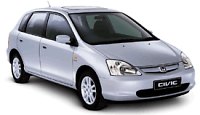 Civic
used to have a special status in my mind. I can easily remember each of
the 6 generations Civic ever lived, from the ’73 Mk1 with CVCC
combustion
technology to the ’95 Mk6 with 3-stage VTEC. That said, innovative
technology
distinguishes it from Western competitors while dynamic image separates
it from Japanese rivals such as Corolla. Simultaneously, it has all the
user-friendliness, reliability and build quality that characterizes
Japanese
cars, no wonder it used to be one of the world’s best sellers, among
Corolla
and Golf.
Civic
used to have a special status in my mind. I can easily remember each of
the 6 generations Civic ever lived, from the ’73 Mk1 with CVCC
combustion
technology to the ’95 Mk6 with 3-stage VTEC. That said, innovative
technology
distinguishes it from Western competitors while dynamic image separates
it from Japanese rivals such as Corolla. Simultaneously, it has all the
user-friendliness, reliability and build quality that characterizes
Japanese
cars, no wonder it used to be one of the world’s best sellers, among
Corolla
and Golf.
 In
fact, the 5-door hatch is easily the best version among all family
members.
While the 4-door Civic sedan is rather predictable, the 5-door have a
body
dimensioned like MPV: very tall, long wheelbase and cab-forward. It
offers
amount of space never heard in this class. At 1.5 meters of height, it
is 65 mm taller than Ford Focus, while 2680 mm wheelbase is again 65
longer
than the benchmark Ford. High roof enables vast of headroom while extra
wheelbase gives rear passengers generous legroom that matches the new
Ford
Mondeo. No, it is actually more spacious than Mondeo, because the floor
is completely flat, without the dummy transmission tunnel thus
benefiting
especially rear middle passenger. To get rid of the dummy transmission
tunnel, Honda had to strengthen the floorpan by adding 6 longitudinal
and
1 transverse beams.
In
fact, the 5-door hatch is easily the best version among all family
members.
While the 4-door Civic sedan is rather predictable, the 5-door have a
body
dimensioned like MPV: very tall, long wheelbase and cab-forward. It
offers
amount of space never heard in this class. At 1.5 meters of height, it
is 65 mm taller than Ford Focus, while 2680 mm wheelbase is again 65
longer
than the benchmark Ford. High roof enables vast of headroom while extra
wheelbase gives rear passengers generous legroom that matches the new
Ford
Mondeo. No, it is actually more spacious than Mondeo, because the floor
is completely flat, without the dummy transmission tunnel thus
benefiting
especially rear middle passenger. To get rid of the dummy transmission
tunnel, Honda had to strengthen the floorpan by adding 6 longitudinal
and
1 transverse beams.  Thanks
to large windows and windscreen, the cabin has a strong glass-house
feel.
The driver and others sit high, in addition to large and light doors,
access
is convenient. Facing the driver is an ordinary instrument panel and a
MPV-inspired center console on which gear shifter is mounted. Placing
shifter
there allow walk-through capability although the handbrake is quite
obstructive.
Style and quality-wise, the dashboard is up to Honda’s standard but not
class’ best. Any MPV-style flexible seating and cargo loading ? sorry,
this Civic is strictly a hatchback in this respect. If you want a real
MPV, the Civic-based Stream could be a good choice.
Thanks
to large windows and windscreen, the cabin has a strong glass-house
feel.
The driver and others sit high, in addition to large and light doors,
access
is convenient. Facing the driver is an ordinary instrument panel and a
MPV-inspired center console on which gear shifter is mounted. Placing
shifter
there allow walk-through capability although the handbrake is quite
obstructive.
Style and quality-wise, the dashboard is up to Honda’s standard but not
class’ best. Any MPV-style flexible seating and cargo loading ? sorry,
this Civic is strictly a hatchback in this respect. If you want a real
MPV, the Civic-based Stream could be a good choice.



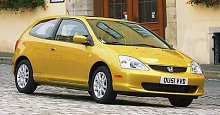 Sometimes
the world is quite fair: while American motorists enjoy lowest car and
fuel prices, they cannot get some of the best cars in the world, for
example,
Honda Civic Type R. Undoubtedly, this car is the King of hot hatches at
the moment, but Honda USA decided to import a cheaper,
tailor-made-for-US
version called Civic Si. The car is based on the 3dr Civic thus is
produced
at Honda's Swindon plant in UK. It shares the same stiffer suspension
setup
with the Type R, but smaller 15-inch wheels wearing higher profile
tyres
should bring more ride comfort in the price of handling sharpness.
Sometimes
the world is quite fair: while American motorists enjoy lowest car and
fuel prices, they cannot get some of the best cars in the world, for
example,
Honda Civic Type R. Undoubtedly, this car is the King of hot hatches at
the moment, but Honda USA decided to import a cheaper,
tailor-made-for-US
version called Civic Si. The car is based on the 3dr Civic thus is
produced
at Honda's Swindon plant in UK. It shares the same stiffer suspension
setup
with the Type R, but smaller 15-inch wheels wearing higher profile
tyres
should bring more ride comfort in the price of handling sharpness.
 Undoubtedly,
the second generation Civic Type R intends to beat the opposition to
become
the world's best hot hatch, a thing the first generation not quite
achieved.
In fact, the domestic bounded first generation was even unheard to many
foreigners - car journalists included. Autocar, Car, Top Gear, Auto
Express
.... none of them mentioned the old car in their reviews of the new
Type
R. So let me start from the old car first.
Undoubtedly,
the second generation Civic Type R intends to beat the opposition to
become
the world's best hot hatch, a thing the first generation not quite
achieved.
In fact, the domestic bounded first generation was even unheard to many
foreigners - car journalists included. Autocar, Car, Top Gear, Auto
Express
.... none of them mentioned the old car in their reviews of the new
Type
R. So let me start from the old car first.
 Now
comes the new Civic Type R. Like the new Civic 3-door, you can find a
label
"Made in Great Britain" as it is produced exclusively in Honda's
Swindon
plant rather than in Japan. This implies 3 things - firstly, sales of
Honda
Europe dropped sharply in recent years so that the Swindon plant has so
much excess capacity to take on any projects; secondly, the new Type R
will be produced in more standardized way rather than human-intensive
method.
Otherwise its production will be left in Japan; lastly, the chassis and
suspensions were thoroughly tested and tuned in Europe, guaranteeing a
world-class handling and ride.
Now
comes the new Civic Type R. Like the new Civic 3-door, you can find a
label
"Made in Great Britain" as it is produced exclusively in Honda's
Swindon
plant rather than in Japan. This implies 3 things - firstly, sales of
Honda
Europe dropped sharply in recent years so that the Swindon plant has so
much excess capacity to take on any projects; secondly, the new Type R
will be produced in more standardized way rather than human-intensive
method.
Otherwise its production will be left in Japan; lastly, the chassis and
suspensions were thoroughly tested and tuned in Europe, guaranteeing a
world-class handling and ride.  I
did not expect the fat, monospace profile looks good in Type R spec.,
but
this time Honda make it just right. Big air dam, side skirts, rear
spoiler
and 17-inch wheels succeed to change how we feel - instead of plain and
bulky, now the car is subtle. Oh yes, the red R logo at the grille also
plays an important role. It reminds me this is not just a GTI, but a
Type
R !
I
did not expect the fat, monospace profile looks good in Type R spec.,
but
this time Honda make it just right. Big air dam, side skirts, rear
spoiler
and 17-inch wheels succeed to change how we feel - instead of plain and
bulky, now the car is subtle. Oh yes, the red R logo at the grille also
plays an important role. It reminds me this is not just a GTI, but a
Type
R !  There
is no question about its claimed 0-60 time of 6.8 seconds and a top
speed
of 146mph. The only hot hatch that could rival and possibly beat the
Type
R is Renault Sport's Clio RS (172), which does 0-60 in 6.6 seconds but
it is no where near the Type R at high speed, blame to inferior
aerodynamics
and less top end grunt due to the lack of VTEC (the Clio has VVT only
but
not variable lift). Once the needle pass 6,000rpm, the Honda engine
goes
mad and it really enters a league of its own - no matter aurally or
objectively.
No other 4-cylinder engines could be so thrilling. However, what makes
the i-VTEC a double-edge sword is that it pulls cleanly right from
1,500rpm
and goes really strong from 3,000rpm where 90% torque is available. The
continuous VVT also smoothens power delivery thus it is refined to use
in daily basis, a thing the old VTEC can hardly claim.
There
is no question about its claimed 0-60 time of 6.8 seconds and a top
speed
of 146mph. The only hot hatch that could rival and possibly beat the
Type
R is Renault Sport's Clio RS (172), which does 0-60 in 6.6 seconds but
it is no where near the Type R at high speed, blame to inferior
aerodynamics
and less top end grunt due to the lack of VTEC (the Clio has VVT only
but
not variable lift). Once the needle pass 6,000rpm, the Honda engine
goes
mad and it really enters a league of its own - no matter aurally or
objectively.
No other 4-cylinder engines could be so thrilling. However, what makes
the i-VTEC a double-edge sword is that it pulls cleanly right from
1,500rpm
and goes really strong from 3,000rpm where 90% torque is available. The
continuous VVT also smoothens power delivery thus it is refined to use
in daily basis, a thing the old VTEC can hardly claim.
 Integra's
6-speed manual is another joy. Although the shifter is mounted on
center
console like many MPVs, it actually shortens the distance travelling
from
steering wheel to shifter. Moreover, shift quality remains unchanged at
the best tradition of Honda - slick, precise and short-throw. 6 close
ratios
keep the engine boiling at VTEC zone.
Integra's
6-speed manual is another joy. Although the shifter is mounted on
center
console like many MPVs, it actually shortens the distance travelling
from
steering wheel to shifter. Moreover, shift quality remains unchanged at
the best tradition of Honda - slick, precise and short-throw. 6 close
ratios
keep the engine boiling at VTEC zone.  While
the Civic Type R is neither as agile nor as fun to handle as Peugeot
306,
it has superior brakes and more grip. Its cabin is also roomier than
most
hot hatches (despite of being 110mm shorter in wheelbase than the
5-door
Civic), and you won't find another one with a flat floor to free up
rear
passenger foot room. So this is a fast hatch having no compromises to
cope
with.
While
the Civic Type R is neither as agile nor as fun to handle as Peugeot
306,
it has superior brakes and more grip. Its cabin is also roomier than
most
hot hatches (despite of being 110mm shorter in wheelbase than the
5-door
Civic), and you won't find another one with a flat floor to free up
rear
passenger foot room. So this is a fast hatch having no compromises to
cope
with. 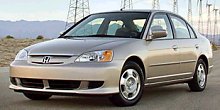 With
Civic Hybrid, Honda finally takes the lead of hybrid vehicle from
Toyota.
The battle started in late 1997 when Toyota launched the world’s first
production hybrid car Prius in Japan. Prius is a practical 4-seater but
Toyota produced it either at a loss or with government incentives to
prevent
from a loss. 2 years later, Honda responded with a 2-seater coupe,
Insight.
Although Insight breaks fuel economy records, it is more like an
experiment
rather than a serious attempt to mass production market. However, it is
this experiment finally leads to the birth of the world’s first
practical
and cost effective hybrid car - Civic Hybrid.
With
Civic Hybrid, Honda finally takes the lead of hybrid vehicle from
Toyota.
The battle started in late 1997 when Toyota launched the world’s first
production hybrid car Prius in Japan. Prius is a practical 4-seater but
Toyota produced it either at a loss or with government incentives to
prevent
from a loss. 2 years later, Honda responded with a 2-seater coupe,
Insight.
Although Insight breaks fuel economy records, it is more like an
experiment
rather than a serious attempt to mass production market. However, it is
this experiment finally leads to the birth of the world’s first
practical
and cost effective hybrid car - Civic Hybrid.
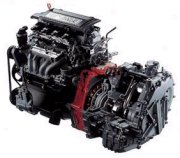 The
DC motor is thin yet more powerful than the Insight's, now delivers
13hp
and 36lbft of torque. Both the power control unit and battery pack are
made smaller to save space. As before, the IMA works like this: during
acceleration both engine and motor operate to provide maximum push; at
cruising, only the engine is working; when decelerating, the motor
regenerates
electricity and recharges the battery; Besides, the engine will shut
down
automatically after stopping a while (for instance, at traffic light)
and
then restart immediately when throttle pedal is pressed.
The
DC motor is thin yet more powerful than the Insight's, now delivers
13hp
and 36lbft of torque. Both the power control unit and battery pack are
made smaller to save space. As before, the IMA works like this: during
acceleration both engine and motor operate to provide maximum push; at
cruising, only the engine is working; when decelerating, the motor
regenerates
electricity and recharges the battery; Besides, the engine will shut
down
automatically after stopping a while (for instance, at traffic light)
and
then restart immediately when throttle pedal is pressed.